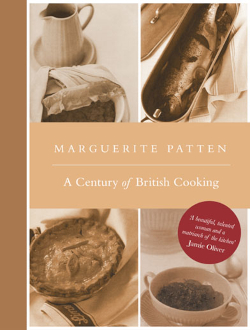Recipe: Pease Pottage or Pease Pudding

The following recipe is taken from Marguerite Patten’s A Century of British Cooking, published by Grub Street in 2015; see page 140.
Boring Historical Stuff
Patten points out that the dish was popular during the Second World War, when meat and many other foodstuffs were difficult to obtain but dried peas were available as part of the rationing allowance.
Pease pottage is assumed to have originated as a peasant food centuries earlier. Similar dishes, “potages” made of “benes”, are mentioned in a late 14th-century recipe book, The Forme of Cury (a fascimile of the Middle English text is available [PDF, 6.7 MB]). Back then, before the arrival of potatoes, pease pottage was presumably eaten throughout the country. These days, the dish is associated mainly with the north-east of England.
According to the Durham Foods Ltd website, pease pottage was the original name of the dish. The more common modern name, pease pudding, caught on with the invention of the pudding cloth, a square of linen which held ingredients together during the boiling process.
The Recipe
The following recipe is flexible. Pease pottage may be made with marrowfat peas or with yellow or green split peas. Vegetables such as carrots or celery may be added at stage 3 or 4 of the recipe. To increase the savoury tone of the dish, the water at stage 4 may be replaced by vegetable stock, and miso paste or Marmite added at stage 4.
Ingredients
Serves 6:
- dried peas: 225 grammes / 8 ounces
- small onions: 2, chopped
- parsley: 1 small bunch
- thyme: several sprigs
- mint: a few leaves
- water: 1.2 litres / 2 pints
- salt: to taste
- ground black pepper: to taste
- butter or margarine or dripping: 25 g / 1 oz
- egg: 1
Method
- Place the dried peas in a container. Add more than enough cold water to cover them. Leave them to soak overnight.
- Strain the peas and discard the water.
- Chop the onions.
- In a saucepan, place:
- the peas,
- the chopped onions,
- the parsley, thyme and mint,
- the salt and pepper,
- the water.
- Bring it to a boil.
- Cover the saucepan, reduce the heat, and allow it to simmer until the peas are acceptably soft: roughly 2 to 2½ hours.
- Towards the end of the cooking time, inspect the mixture. If there is a noticeable amount of liquid, remove the lid and keep simmering until the liquid has evaporated.
- Pass the mixture through a sieve, or use a food mixer, until it forms a paste that is as smooth or lumpy as you prefer.
- Add the butter (or margarine or dripping) and the egg.
- Mix it all together.
- Grease the inside of a pudding basin.
- Place the mixture in the basin.
- Cover the mixture with a piece of greaseproof paper.
- Place the basin in a steamer, or suspend it over a saucepan of boiling water, and steam it for one hour.
Serve it hot, although some prefer it cold …
Nursery Rhyme
Pease pottage hot, pease pottage cold,
pease pottage in the pot, nine days old.
Some like it hot, some like it cold,
some like it in the pot, nine days old.
If you’re intending to keep it for nine days, it’s probably best to remove it from the pot and stick it in the fridge.
As Eaten by Samuel Pepys
Pease pottage, in one of its alternative names, was mentioned by Samuel Pepys in his diaries:
At noon I went home and dined with my wife on pease porridge and nothing else
and:
and so back again to the Cocke [a tavern on Bow Street], and there find Mr. Turner, Betty, and Talbot Pepys, and they dined with myself Sir D. Gawden and Gibson, and mighty merry, this house being famous for good meat, and particularly pease-porridge and after dinner broke up, and they away; and I to the Council-Chamber, and there heard the great complaint of the City, tried against the gentlemen of the Temple, for the late riot, as they would have it, when my Lord Mayor was there.
Mr and Mrs Pepys were probably in a minority when dining on “pease porridge and nothing else.” Pease pottage (or pease pudding, or pease porridge) is usually a side dish, as a line from the song ‘Food, Glorious Food’ from Lionel Bart’s musical Oliver! suggests:
Food, glorious food,
Hot sausage and mustard!
While we’re in the mood —
Cold jelly and custard!
Pease pudding and saveloys
What next is the question?https://www.classactor.org/resources/OLIVER!-Script.pdf [21.9 MB], p.1
Incidentally, adventurous cooks may like to know that the Pepys Diary website contains a couple of early recipes for pease pottage (or pease pudding, or pease porridge).